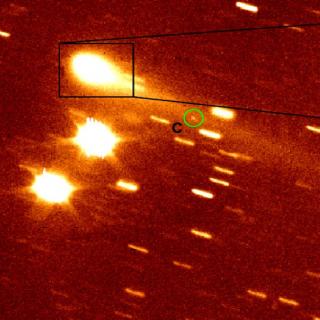Bibcode
Mazzotta Epifani, E.; Perna, D.; Licandro, J.; Dall'Ora, M.; Palumbo, P.; Dotto, E.; Barucci, M. A.; Brucato, J. R.; Della Corte, V.; Tozzi, G. P.
Bibliographical reference
Astronomy and Astrophysics, Volume 565, id.A69, 8 pp.
Advertised on:
5
2014
Journal
Citations
15
Refereed citations
15
Description
Aims: We present a portrait of the active Centaur P/2010 C1
(Scotti), observed with a well developed comet-like activity (central
diffuse coma condensation and an extended sharp tail-like structure) at
the heliocentric distance of rh = 5.5 AU. Methods: We
analyse multicolour (B, V, R, and I) images taken at the TNG telescope
to characterise the dust coma of the active Centaur and to investigate
its photometry, colours, and dust production, and to gain hints to its
nucleus size. Results: P/2010 C1 (Scotti) has a small nucleus
(<4.8 km in radius), with visual colour V - R = 0.49 ± 0.03
typical of the nuclei of Jupiter-family comets, but with a dust coma
much redder (B - I = 2.37 ± 0.13) than both the Sun and the
typical comet mucleus. It has an integrated R magnitude of mR
= 21.41 ± 0.02 and R-Afρ = 34 ± 2 cm (all measured in
the reference aperture of radius φ = 2.0''), which is much lower
than has been measured for other active Centaurs at similar heliocentric
distances. Its dust production rate, Qd = 0.1-15 kg/s,
depicts P/2010 C1 (Scotti) as a rather weak dust emitter, with a
dust-loss rate comparable to that of the weakest Jupiter-family comets
at shorter heliocentric distance and to the weakest active Centaur
characterised to now.
Based on observations collected at the Italian Telescopio Nazionale
Galileo (TNG), operated on the island of La Palma by the Centro Galileo
Galilei of the INAF (Istituto Nazionale di Astrofisica) at the Spanish
Observatorio del Roque de los Muchachos of the Instituto de
Astrofísica de Canarias.
Related projects

Exoplanets and Astrobiology
The search for life in the universe has been driven by recent discoveries of planets around other stars (known as exoplanets), becoming one of the most active fields in modern astrophysics. The growing number of new exoplanets discovered in recent years and the recent advance on the study of their atmospheres are not only providing new valuable
Enric
Pallé Bago

Small Bodies of the Solar System
This project studies the physical and compositional properties of the so-called minor bodies of the Solar System, that includes asteroids, icy objects, and comets. Of special interest are the trans-neptunian objects (TNOs), including those considered the most distant objects detected so far (Extreme-TNOs or ETNOs); the comets and the comet-asteroid
Julia de
León Cruz